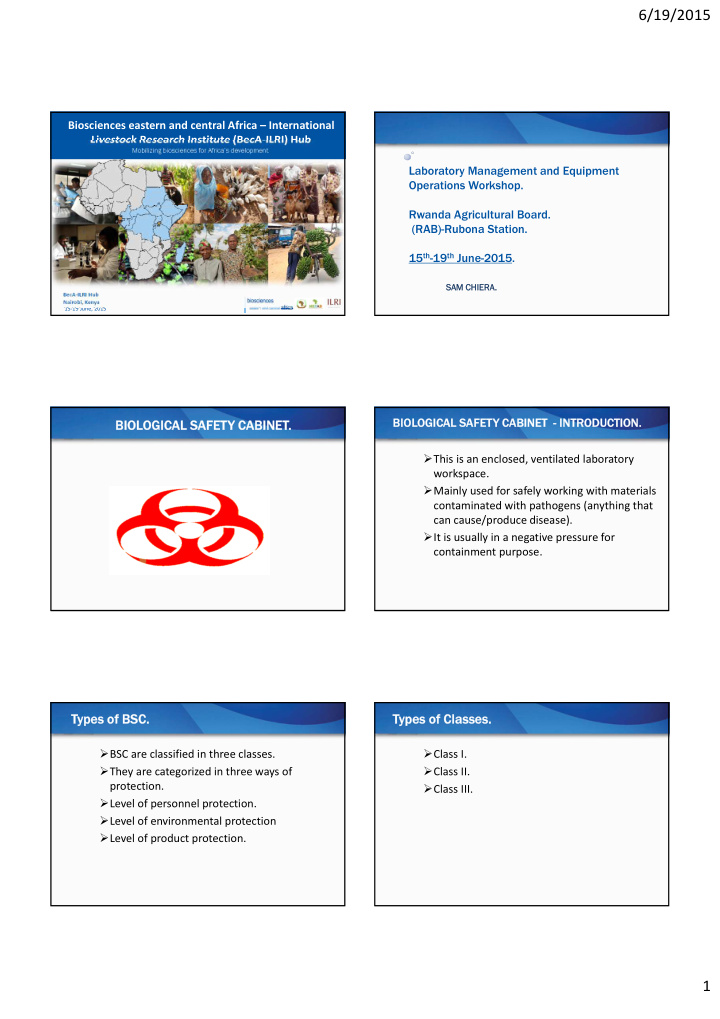



6/19/2015 Biosciences eastern and central Africa – International Livestock Research Institute (BecA ‐ ILRI) Hub Mobilizing biosciences for Africa’s development Laboratory Management and Equipment Operations Workshop. Rwanda Agricultural Board. (RAB)-Rubona Station. 15 th -19 th June-2015. SAM CHIERA. SAM CHIERA. BecA ‐ ILRI Hub Nairobi, Kenya 15 ‐ 19 June, 2015 BIOLOGICAL S SAFE FETY C CABINET - INT INTRODUCTION. N. BIOLOGIC BIOL ICAL S SAFET FETY CABIN CABINET. � This is an enclosed, ventilated laboratory workspace. � Mainly used for safely working with materials contaminated with pathogens (anything that can cause/produce disease). � It is usually in a negative pressure for containment purpose. Ty Types o of BSC. Types o pes of Classes. sses. � BSC are classified in three classes. � Class I. � They are categorized in three ways of � Class II. protection. � Class III. � Level of personnel protection. � Level of environmental protection � Level of product protection. 1
6/19/2015 Classif ssifications. cations. Class 1 ss 1. � Class I. cabinets provide personnel protection but no product protection and environmental. Classification Biosafety Level Application low to moderate risk � this class are either ducted (connected to the Class I 1, 2, 3 biological agents building exhaust system) or unducted low to moderate risk (recirculating filtered exhaust back into the Class II 1, 2, 3 biological agents laboratory). Class III 4 high risk biological agents BSC- BSC-CL CLAS ASS I. S I. Class I ss II � Class II cabinets provide both kinds of protection of the samples and of the environment. � makeup air is also HEPA ‐ filtered (High Efficiency Particulate Air). � These are further classified as Type A1,Type A2,Type B1,Type B2. � Each type's requirements are defined by NSF International Standard 49. BSC- BSC-CL CLAS ASS II S II Type A1 A1 (class (class II). II). � The Type A1 cabinet has a minimum inflow velocity of 75 ft./min. � The filtered makeup air is divided equally over the work surface at about two to six inches above the work surface. � Exhaust is drawn at the bottom of the cabinet where it rises to the top. � At the top of the cabinet, 70% of the air recirculates through the supply HEPA filter, the other 30% of air exhausted through the exhaust HEPA filter. 2
6/19/2015 BSC-CL BSC-CLAS ASS S II T II TYPE PE A I A I Type A 2 (clas A 2 (class II). II). � Has a minimum inflow velocity of 100 ft/min. � A negative air pressure plenum surrounds all contaminated plenums that are under positive pressure. BSC- BSC-CL CLAS ASS S II T II TYPE PE A II A II Type B1 B1 (clas (class II). II). � The Type B1 cabinets have a minimum inflow velocity of 100 ft/min. � These cabinets must be hard ‐ ducted to an exhaust system( In contrast to the type A1 and A2 cabinets, 60% of air from the rear grille is exhausted and only 40% is recirculated ). BSC- BSC-CL CLAS ASS II S II TYPE PE B B I Type B2 B2 (clas (class II). II). � Type B2 cabinets have a minimum inflow velocity of 100 ft/min � Type B2 cabinet is expensive to operate because no air is recirculated within. � this type is mainly found in such applications as toxicology laboratories. � cabinets of these types generally monitor the exhaust flow, shutting off the supply blower and sounding an alarm if the exhaust flow is insufficient. 3
6/19/2015 BSC- BSC-CL CLAS ASS II S II TYPE PE B B II II Clas Class III. III. � Class III cabinet, generally only installed in maximum containment laboratories. � Specifically designed for work with BSL ‐ 4 pathogenic agents, providing maximum protection (A pathogen is anything that causes a disease). � The enclosure is gas ‐ tight. � All materials enter and leave through a dunk tank or double ‐ door autoclave. BSC- BSC-CL CLAS ASS III. S III. Cont. Cont. � Gloves attached to the front prevent direct contact with hazardous materials. � These cabinets are sometimes called glove box. � Provide a physical barrier between biological agents and personnel. Bi Biol ological ogical Saf Safety C ty Cabinet T net Testing sting & Validation. ation. BSC- BSC- CLAS CLASS III III 4
6/19/2015 Certif ification. ication. When. When � A Biological Safety Cabinet MUS MUST be be � Initial Installation. certifi cer ified. � Moved or Relocated. � must be performed by experienced, � After a Major Repair. qualified personnel. � Annually. � On-site testing following the recommendations for field testing [NSF/ANSI 49-2011. Ty Types o of certificates. Types o pes of tests. sts. � down flow velocity. � inflow velocity. � airflow smoke patterns. � filter leak. � light intensity. � Vibration. � noise level � UV light integrity Thank you Samuel Gakuha Chiera Engineering Technician ILRI Nairobi Kenya Engineering Department s.chiera@cgiar.org Mobilizing biosciences for Africa’s development http://hub.africabiosciences.org 5
Recommend
More recommend